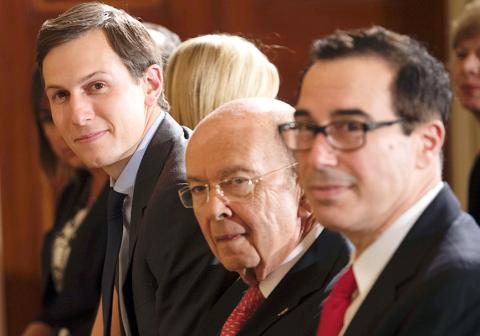US President Donald Trump’s administration is considering using rarely invoked US trade laws to fend off China’s demands that foreign companies share their technology in return for access to the country’s vast market, a person familiar with US discussions said yesterday.
The administration is discussing the use of Section 301 of the US Trade Act of 1974, which empowers Washington to launch an investigation into China’s trade practices and, within months, raise tariffs on imports from China, or impose other sanctions, said the person, who spoke on condition of anonymity because the plans have not been made public.
The investigation would be focused on China’s alleged “forced technology transfer policies and practices,” the person said, adding that the Trump administration could move to launch such an investigation this week.

Photo: AFP
The Chinese Ministry of Commerce did not immediately respond to a request for comment.
The deliberations come as the administration signals a harsher stance on trade than it took in the first six months of Trump’s presidency.
US and other Western governments and business groups accuse Beijing of blocking access to promising industries by requiring foreign companies to hand over proprietary technologies in exchange for being allowed to operate in the nation.
Such requirements are seen as an attempt by Beijing to nurture its own competitors.
Trump set aside complaints about market access and currency when he met with Chinese President Xi Jinping (習近平) in April in hopes Beijing would help pressure North Korea to end its nuclear weapons development.
However, tensions bubbled up last month at a US-Chinese dialogue where US Secretary of the Treasury Steve Mnuchin blamed China’s US$347 billion trade surplus with the US last year on Chinese “government intervention in its economy.”
US Secretary of Commerce Wilbur Ross, in a commentary in Tuesday’s Wall Street Journal, outlined a slew of grievances against China and the EU that he said contributed to the global US trade deficit in goods last year of US$725.5 billion.
“Both China and Europe also bankroll their exports through grants, low-cost loans, energy subsidies, special value-added tax refunds and below-market real-estate sales, among other means,” Ross wrote.

The Central Weather Administration (CWA) yesterday said it expected to issue a sea warning for Typhoon Fung-Wong tomorrow, which it said would possibly make landfall near central Taiwan. As of 2am yesterday, Fung-Wong was about 1,760km southeast of Oluanpi (鵝鑾鼻), Taiwan’s southernmost point, moving west-northwest at 26kph. It is forecast to reach Luzon in the northern Philippines by tomorrow, the CWA said. After entering the South China Sea, Typhoon Fung-Wong is likely to turn northward toward Taiwan, CWA forecaster Chang Chun-yao (張峻堯) said, adding that it would likely make landfall near central Taiwan. The CWA expects to issue a land

Taiwan’s exports soared to an all-time high of US$61.8 billion last month, surging 49.7 percent from a year earlier, as the global frenzy for artificial intelligence (AI) applications and new consumer electronics powered shipments of high-tech goods, the Ministry of Finance said yesterday. It was the first time exports had exceeded the US$60 billion mark, fueled by the global boom in AI development that has significantly boosted Taiwanese companies across the international supply chain, Department of Statistics Director-General Beatrice Tsai (蔡美娜) told a media briefing. “There is a consensus among major AI players that the upcycle is still in its early stage,”

The Central Weather Administration (CWA) yesterday said it is expected to issue a sea warning for Typhoon Fung-wong this afternoon and a land warning tomorrow. As of 1pm, the storm was about 1,070km southeast of Oluanpi (鵝鑾鼻), Taiwan’s southernmost point, and was moving west-northwest at 28 to 32kph, according to CWA data. The storm had a radius of 250km, with maximum sustained winds of 173kph and gusts reaching 209kph, the CWA added. The storm is forecast to pass near Luzon in the Philippines before entering the South China Sea and potentially turning northward toward Taiwan, the CWA said. CWA forecaster Chang Chun-yao (張峻堯) said

Japanese Prime Minister Sanae Takaichi yesterday said that China using armed force against Taiwan could constitute a "survival-threatening situation" for Japan, allowing the country to mobilize the Japanese armed forces under its security laws. Takaichi made the remarks during a parliamentary session while responding to a question about whether a "Taiwan contingency" involving a Chinese naval blockade would qualify as a "survival-threatening situation" for Japan, according to a report by Japan’s Asahi Shimbun. "If warships are used and other armed actions are involved, I believe this could constitute a survival-threatening situation," Takaichi was quoted as saying in the report. Under Japan’s security legislation,